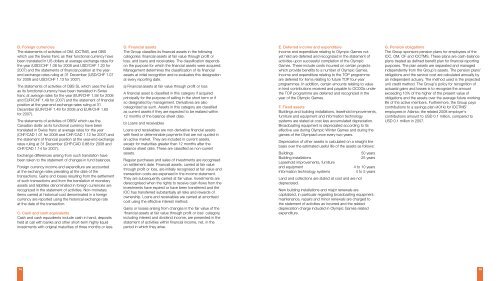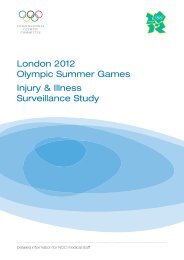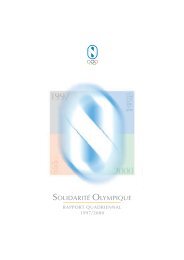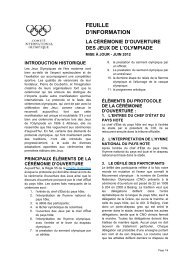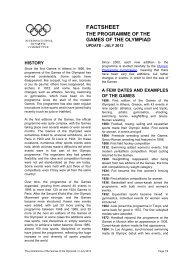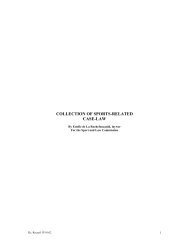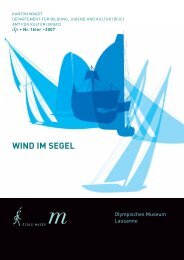3912 reportcomplete final web:layout 1
3912 reportcomplete final web:layout 1
3912 reportcomplete final web:layout 1
Create successful ePaper yourself
Turn your PDF publications into a flip-book with our unique Google optimized e-Paper software.
B. Foreign currencies<br />
The statements of activities of OM, IOCTMS, and OBS<br />
which use the Swiss franc as their functional currency have<br />
been translated in US dollars at average exchange rates for<br />
the year (USD/CHF 1.08 for 2008 and USD/CHF 1.20 for<br />
2007) and the statements of financial position at the yearend<br />
exchange rates ruling at 31 December (USD/CHF 1.07<br />
for 2008 and USD/CHF 1.13 for 2007).<br />
The statements of activities of OBS SL which uses the Euro<br />
as its functional currency have been translated in Swiss<br />
franc at average rates for the year (EUR/CHF 1.58 for 2008<br />
and EUR/CHF 1.49 for 2007) and the statement of financial<br />
position at the year-end exchange rates ruling at 31<br />
December (EUR/CHF 1.49 for 2008 and EUR/CHF 1.65<br />
for 2007).<br />
The statements of activities of OBSV which use the<br />
Canadian dollar as its functional currency have been<br />
translated in Swiss franc at average rates for the year<br />
(CHF/CAD 1.01 for 2008 and CHF/CAD 1.12 for 2007) and<br />
the statement of financial position at the year-end exchange<br />
rates ruling at 31 December (CHF/CAD 0.88 for 2008 and<br />
CHF/CAD 1.14 for 2007).<br />
Exchange differences arising from such translation have<br />
been taken to the statement of changes in fund balances.<br />
Foreign currency income and expenditure are accounted<br />
at the exchange rates prevailing at the date of the<br />
transactions. Gains and losses resulting from the settlement<br />
of such transactions and from the translation of monetary<br />
assets and liabilities denominated in foreign currencies are<br />
recognized in the statement of activities. Non-monetary<br />
items carried at historical cost denominated in a foreign<br />
currency are reported using the historical exchange rate<br />
at the date of the transaction.<br />
C. Cash and cash equivalents<br />
Cash and cash equivalents include cash in hand, deposits<br />
held at call with banks and other short-term highly liquid<br />
investments with original maturities of three months or less.<br />
D. Financial assets<br />
The Group classifies its financial assets in the following<br />
categories: financial assets at fair value through profit or<br />
loss, and loans and receivables. The classification depends<br />
on the purpose for which the financial assets were acquired.<br />
Management determines the classification of its financial<br />
assets at initial recognition and re-evaluates this designation<br />
at every reporting date.<br />
a) Financial assets at fair value through profit or loss<br />
A financial asset is classified in this category if acquired<br />
principally for the purpose of selling in the short term or if<br />
so designated by management. Derivatives are also<br />
categorized as such. Assets in this category are classified<br />
as current assets if they are expected to be realized within<br />
12 months of the balance sheet date.<br />
b) Loans and receivables<br />
Loans and receivables are non-derivative financial assets<br />
with fixed or determinable payments that are not quoted in<br />
an active market. They are included in current assets,<br />
except for maturities greater than 12 months after the<br />
balance sheet date. These are classified as non-current<br />
assets.<br />
Regular purchases and sales of investments are recognised<br />
on settlement date. Financial assets, carried at fair value<br />
through profit or loss, are initially recognised at fair value and<br />
transaction costs are expensed in the income statement.<br />
They are subsequently carried at fair value. Investments are<br />
derecognised when the rights to receive cash flows from the<br />
investments have expired or have been transferred and the<br />
IOC has transferred substantially all risks and rewards of<br />
ownership. Loans and receivables are carried at amortised<br />
cost using the effective interest method.<br />
Gains or losses arising from changes in the fair value of the<br />
‘financial assets at fair value through profit or loss’ category,<br />
including interest and dividend income, are presented in the<br />
statement of activities within financial income, net, in the<br />
period in which they arise.<br />
E. Deferred income and expenditure<br />
Income and expenditure relating to Olympic Games not<br />
yet held are deferred and recognized in the statement of<br />
activities upon successful completion of the Olympic<br />
Games. These include costs incurred on certain projects<br />
which provide benefits to a number of Olympic Games.<br />
Income and expenditure relating to the TOP programme<br />
are deferred for items relating to future TOP four-year<br />
programmes. In addition, certain amounts relating to value<br />
in kind contributions received and payable to OCOGs under<br />
the TOP programme are deferred and recognized in the<br />
year of the Olympic Games.<br />
F. Fixed assets<br />
Buildings and building installations, leasehold improvements,<br />
furniture and equipment and information technology<br />
systems are stated at cost less accumulated depreciation.<br />
Broadcasting equipment is depreciated according to its<br />
effective use during Olympic Winter Games and during the<br />
games of the Olympiad once every two years.<br />
Depreciation of other assets is calculated on a straight line<br />
basis over the estimated useful life of the assets as follows:<br />
Buildings 50 years<br />
Building installations 25 years<br />
Leasehold improvements, furniture<br />
and equipment 4 to 10 years<br />
Information technology systems 4 to 5 years<br />
Land and collections are stated at cost and are not<br />
depreciated.<br />
New building installations and major renewals are<br />
capitalized, in particular regarding broadcasting equipment;<br />
maintenance, repairs and minor renewals are charged to<br />
the statement of activities as incurred and the related<br />
depreciation charge included in Olympic Games related<br />
expenditure.<br />
G. Pension obligations<br />
The Group sponsors pension plans for employees of the<br />
IOC, OM, OF and IOCTMS. These plans are cash-balance<br />
plans treated as defined benefit plan for financial reporting<br />
purposes. The plan assets are separated and managed<br />
independently from the Group’s assets. The pension plans’<br />
obligations and the service cost are calculated annually by<br />
an independent actuary. The method used is the projected<br />
unit credit method. The Group’s policy for recognition of<br />
actuarial gains and losses is to recognize the amount<br />
exceeding 10% of the higher of the present value of<br />
obligations and the assets over the average future working<br />
life of the active members. Furthermore, the Group pays<br />
contributions to a savings plan (401k) for IOCTMS’<br />
employees in Atlanta; the related 2008 employer’s<br />
contributions amount to USD 0.1 million, compared to<br />
USD 0.1 million in 2007.<br />
74 75


